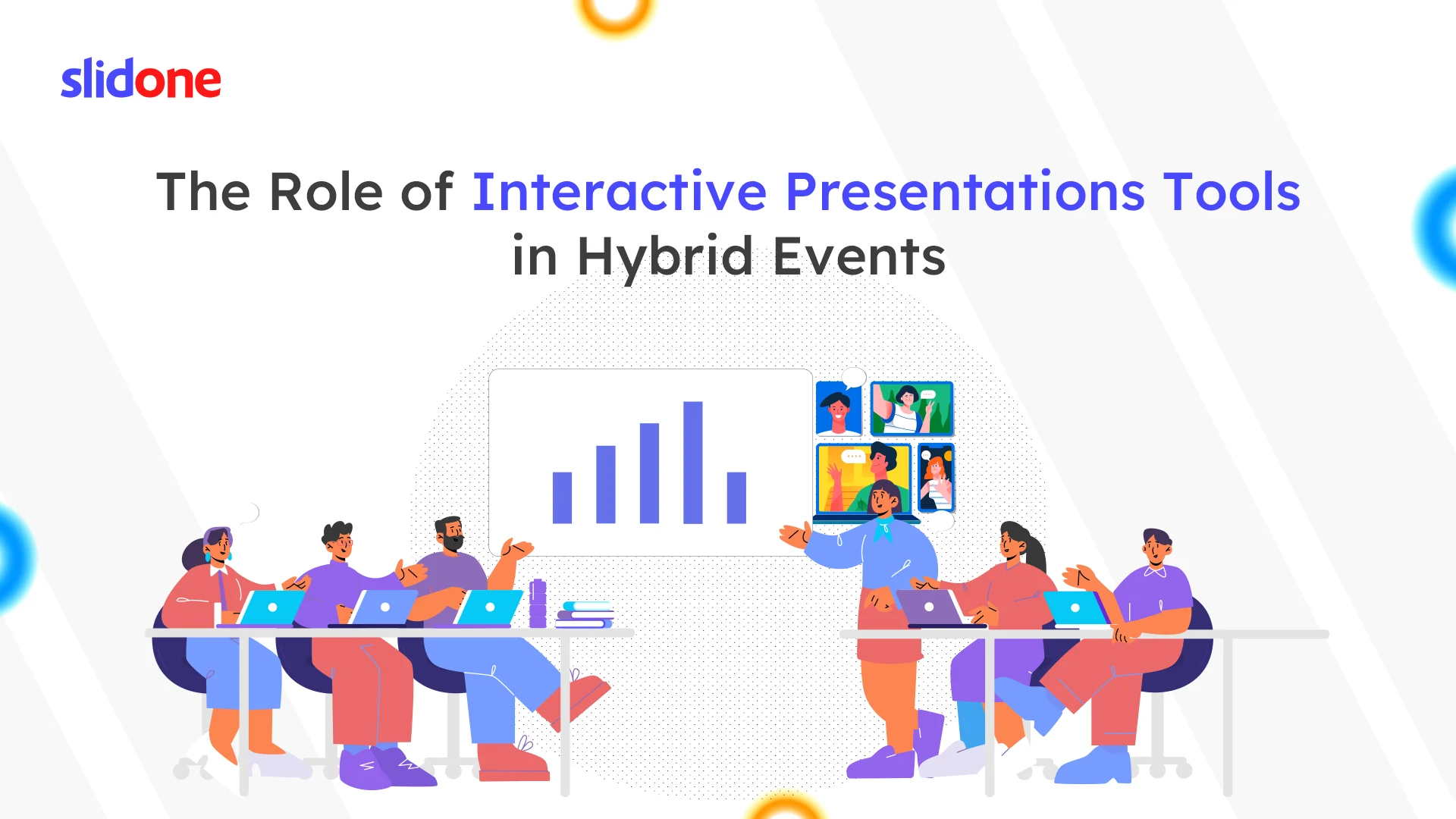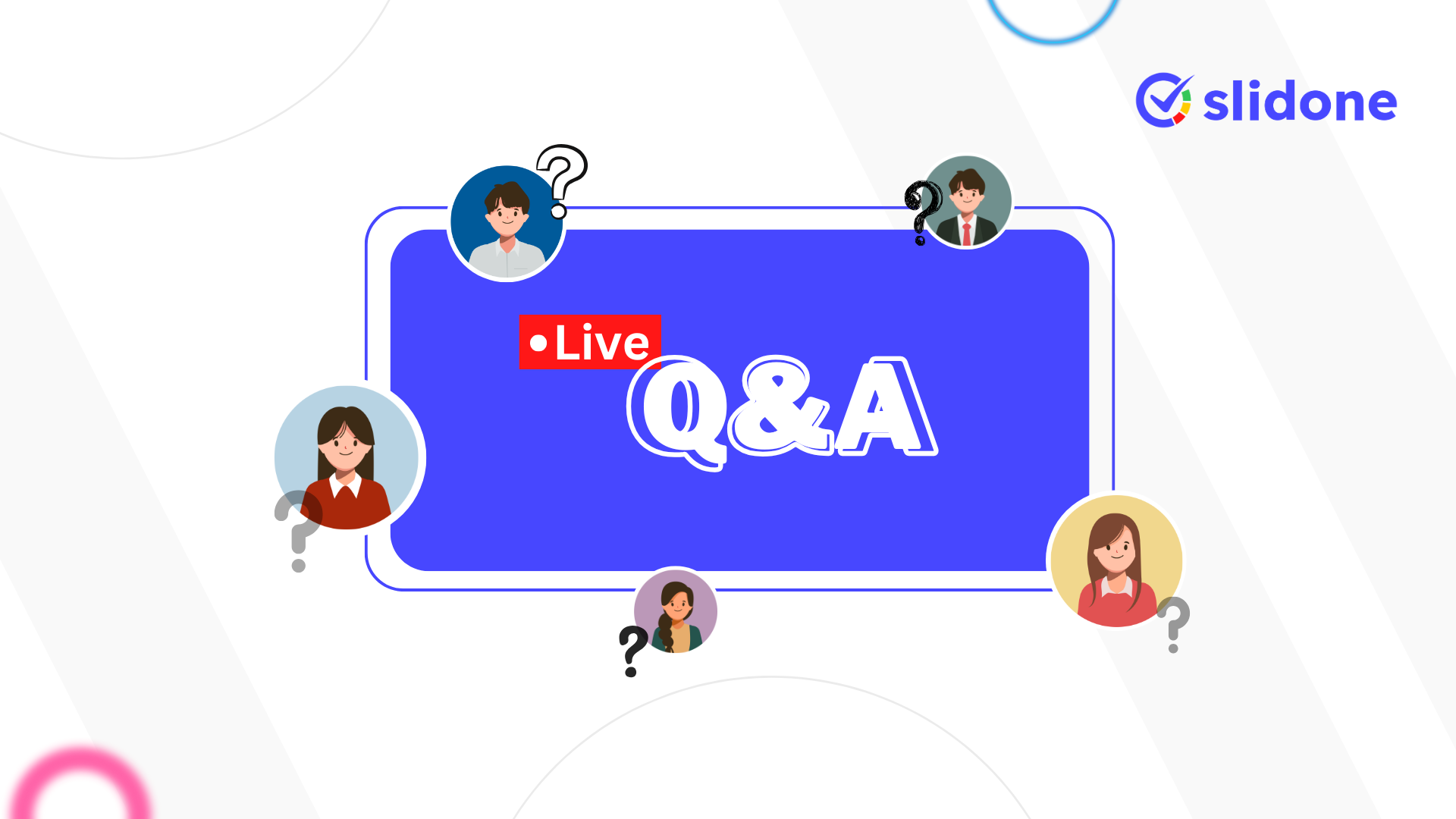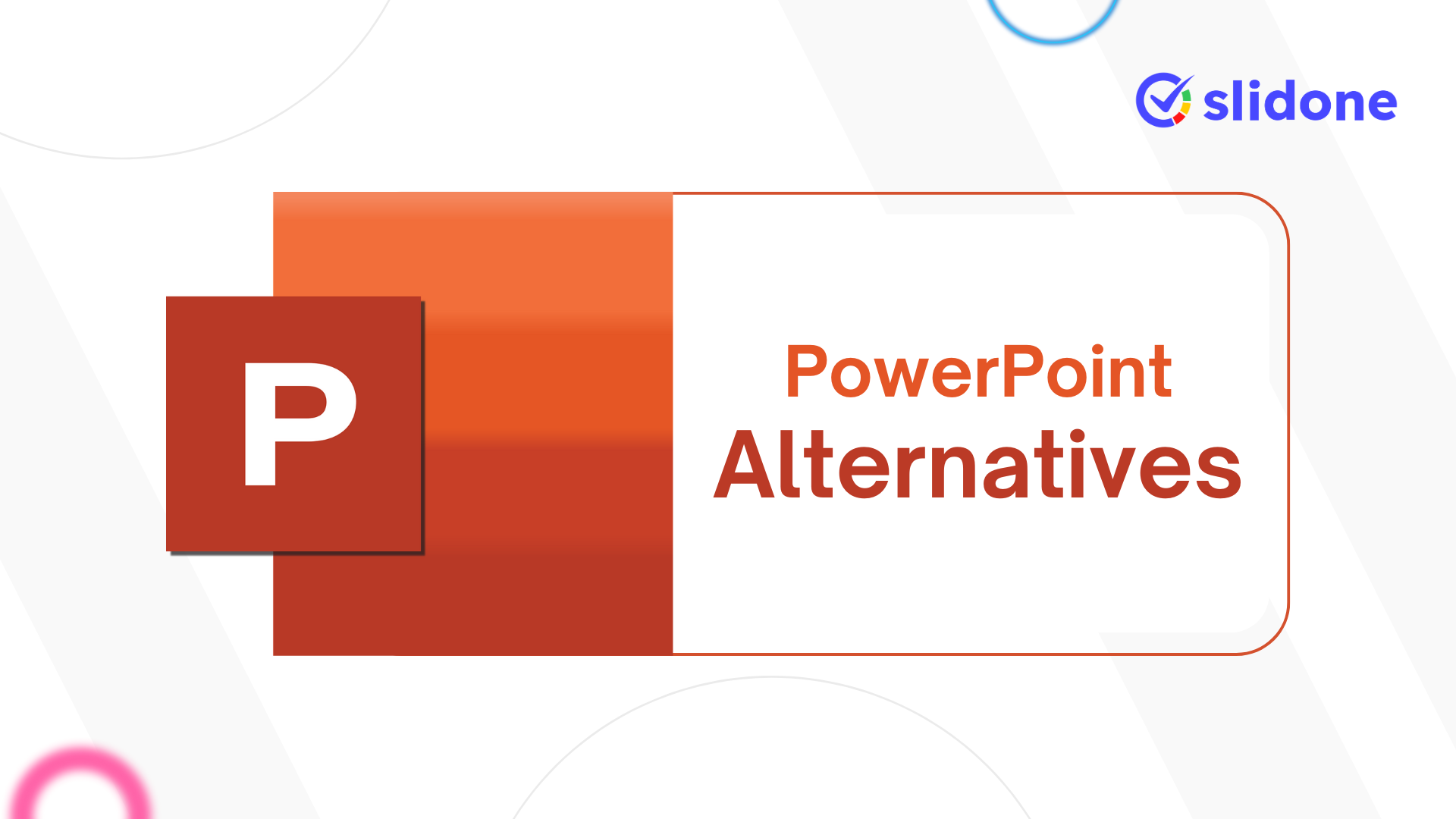Hybrid events effectively combine real-world and practical experiences, and interactive presentation tools are critical to ensuring success. These tools foster engagement, bridge audience gaps, and provide seamless communication for all stakeholders. They enable real-time interaction, ensuring that everyone in attendance feels included. Gamified elements like quizzes and leaderboards make the session dynamic and memorable. Additionally, the use of analytics enables event organizers to measure success and continue to improve the attendee experience for future events.
What is a Hybrid Event?
A hybrid event is a combination of physical and virtual experiences that attendees can participate in person or online. This format allows organizers to expand their horizons, accommodate different priorities, and ensure attendees’ flexibility. Hybrid events are common in conferences, training sessions, corporate events and product launches.
Key features include:
Two-way communication
Individuals and remote viewers can contribute equally. Features like live polls, Q&A and word clouds ensure everyone has a voice. This promotes unity and benefits all in attendance. Real-time feedback fills communication gaps, enabling better communication and decision-making.
Scalable Participation
Supports mass attendance without physical space limitations. Virtual participants can seamlessly join anywhere, ensuring inclusion. Advanced tools handle high-speed connectivity without performance issues. This scalability allows events to reach a global audience while maintaining an interactive quality.
Types of Hybrid Events
Here are some common types of hybrid events:
1. Hybrid Conferences
Connect on-site keynotes to those virtually engaged remotely. Interactive tools such as question and answer sessions ensure that everyone’s voice is heard. Networking lounges or breakout classes can bring together in-person and virtual attendees for seamless collaboration. Feedback analysis provides insights into audience satisfaction and areas for improvement.
2. Hybrid Training Programs
Instructors deliver sessions to individual students while virtual attendees participate through questions, polls, and multimedia presentations. Real-time analytics helps measure the rationality of both categories simultaneously. Interactive tools such as whiteboards aid collaboration and retention. Recordings can also be provided for future reference.
3. Hybrid product launches
Showing the product live to an on-site audience brings the program to an online audience. Both surveys and surveys collect immediate feedback from the audience. The displays can be 3D graphics or AR for increased interactivity. Social media integration increases engagement, encouraging attendees to share experiences.
4. Hybrid Corporate Meetings
Combine physical boardroom discussions with virtual team participation, ensuring everyone is included. Features like shared slides, live word clouds, and Q&A make meetings collaborative. The analytics tool tracks how attendees engage and engage both in-person and remotely. Everyone’s immediate feedback makes decision-making processes faster and more efficient.
Benefits of Hybrid Events
1. Increased Reach and Accessibility
Hybrid systems connect global audiences by allowing participants to engage virtually. Personal attendance is ensured due to travel or time constraints. Virtual attendance options also accommodate different times, allowing for more flexible participation. Recording allows the audience to relive the program at their convenience, making it more accessible.
2. Cost-Effective
The hybrid design reduces the cost of travel, accommodation and space for large groups. Virtual options eliminate logistical costs by providing opportunities for meaningful interaction. Event organizers can reinvest the savings into better technology or enhanced experiences for in-person and in-person attendees.
3. Enhanced Engagement
Interactive tools such as polls, word clouds and live Q&As make hybrid meetings more dynamic and participatory. Attendees feel equally involved, breaking the experience of passive viewing. Interactive elements such as quizzes and leaderboards foster a sense of competition and active participation in both settings.
4. Real-Time Analytics
Event organizers can track attendance, participation and audience reaction in real time. Analytics helps us understand audience behavior, such as which segments were the most interactive. This insight enables continuous improvement for future events, leading to optimal results with multiple iterations.
5. Environmental Sustainability
Hybrid events significantly reduce carbon footprints by reducing the need for transportation. By accommodating fewer individual attendees, venues use less energy. These practices align with corporate social responsibility goals and demonstrate a commitment to sustainability and environmental impact.
The Significant Role of Interactive Tools in Hybrid Events
Interactive tools are the backbone of successful hybrid systems. Here is how they make a difference.
1. Fostering Engagement
Interactive features like live surveys, word clouds, and live quizzes turn passive listeners into active participants. Virtual attendees feel more like contributing their ideas or voting on topics in real time. These tools encourage everyone to share their ideas, making the meeting more dynamic and inclusive. When pictures are added to interactive tools, they are more attention-grabbing and keep interest going throughout the program.
2. Real-Time Feedback
Surveys and instant quizzes help presenters gauge their audience’s understanding on the spot. If attendees express confusion or little engagement, participants can adjust their comments to clarify or emphasize specific areas. These changes enhance audience satisfaction and enhance conference relevance. Real-time feedback also creates a sense of conversation, helping virtual attendees feel as valued as those in the room.
3. Encouraging Collaboration
Shared whiteboards and collaborative slides create spaces for brainstorming and teamwork. Teams can present ideas simultaneously, regardless of physical location, ensuring everyone’s perspective is heard. This approach fosters creativity and improves team dynamics. Collaborative tools break down physical barriers and make hybrid systems feel seamless.
4. Creating a Memorable Experience
Playful activities such as leaderboards and quizzes bring fun and energy to hybrid meetings. Dynamic images such as animations or infographics attract the audience. These features ensure that attendees remember the event as fun and valuable. By blending education with entertainment, the presenters leave a lasting impression on those who participate.
Bridging the Gap Between In-Person and Virtual Attendees
One of the biggest challenges with hybrid events is ensuring that virtual attendees feel the same value. Interactive tools solve this problem by:
Shared Experiences
Tools like live polling or quizzes give everyone a chance to participate, and get everyone involved. These tools help bridge the gap between physical and physical attendees, creating a unified meeting environment. Responses from both groups can be displayed together, making collaboration seamless. This shared connection helps strengthen audience engagement and breaks down barriers of physical separation.
Unified Communication
Discussion features and virtual Q&A sessions connect participants with each other and with speakers. Virtual attendees can help keep the conversation going without interrupting the meeting. A dedicated discussion moderator can ensure that questions from both groups get equal attention, making communication a breeze. This allows everyone to feel heard and included in the conversation.
Equal opportunities to respond
Real-time tools allow virtual attendees to voice their opinions on the same basis as individual participants. Things like anonymous reviews or surveys encourage openness without fear of judgment. Physical and participatory audiences are accurately represented while responses are transparent. This inclusiveness fosters a sense of fairness and encourages active participation.
For example
In hybrid sessions, virtual and in-person attendees can use the same platform to participate in live polls and questions. Showing the results together on screen gives the audience a sense of teamwork and camaraderie. This shared experience makes the event engaging and connects all participants, regardless of location.
How to convert to hybrid events with an interactive presentation tool?
Planning for everyone involved
Make sure your plan balances the needs of physical and physical attendees. Use tools that facilitate equal participation, such as shared voting and question-and-answer sessions. Include times of appropriate rest periods. Organize interactive activities, such as group challenges, that work in physical and digital spaces. This ensures that no one involved feels left out.
Choose the Right Tools
Platforms like Slidone offer features like polls, quizzes, and multimedia tools designed for hybrid environments. Find tools that integrate seamlessly with both in-person and virtual setups. Ensure that the platform supports cross-device compatibility for participants using different devices. Advanced analytics features can also help measure engagement of both audiences.
Include both audiences
Use interesting images and exchange interactive elements that are enjoyable for both groups. For example, start with an icebreaker survey that combines reactions from both audiences. Bring together the ideas of all attendees and use activities like living word clouds as a shared moment. This keeps everyone connected and actively engaged throughout the event.
Test your plan
Perform a thorough technical study when checking for any problems with equipment, software, or communications. Copy experiences in real and virtual and to ensure a seamless integration. Use features like screen sharing, audience polling, or video streaming to fix potential issues in advance. This reduces interruptions and creates a smooth experience for all involved.
Provide technical support
Hire a dedicated team to provide immediate support for attendees experiencing platform or connectivity issues. Share instructions or quick start tutorials before the event to familiarize participants with the platform. Make sure you can access support via chat or phone during the meeting to resolve technical difficulties quickly. This support enhances the experience and builds confidence in attendees.
Role of Presentation Integration Software in Hybrid Meetings
Presentation integration software simplifies the complexity of managing hybrid events.
1. Proper preparation
Existing slides, which can be easily downloaded from platforms like PowerPoint or Google Slides, save time while creating content. Include interactive elements such as direct polling or Q&A to make the presentations interesting. Ensure consistency by using pre-made templates that match your branding. Integration software allows teachers to innovate quickly without having to start from scratch.
2. Centralized data management
Collect feedback, meeting analysis, and participant data in one central location for easy access and review. This simplifies tracking and ensures important data isn’t scattered across platforms. Provide a history of submissions for future use or performance monitoring. Secure storage simplifies data recovery during audits or analysis.
3. Cross-platform compatibility
Make sure to seamlessly integrate with platforms like Zoom, Microsoft Teams, and other webinar tools, to enhance the hybrid experience. The presentations can be accessed on various devices without formatting issues, to ensure inclusion of all attendees. Integrated discussion and Q&A features provide an integrated communication platform in forums. This assures attendees’ continued engagement both personally and remotely.
4. Time-saving features
Pre-designed designs and automated tools simplify preparation, allowing teachers to focus on presenting information. Save frequently used slides for reuse, reducing the effort of repeated meetings or training sessions. Automation features like auto-sync updates ensure consistency across versions. This not only saves time but also increases productivity.
For example:
For training, do presentations with questions and answers and surveys interspersed with interactive slides. Send session formats to virtual attendees, keeping both audiences engaged without trying twice. This method improves efficiency and reduces maintenance time.
Conclusion
Hybrid events are the future of collaboration, combining the benefits of in-person and virtual experiences. Interactive tools ensure that all attendees are engaged and interact with each other no matter their location. With presentation integration software, you can streamline collaboration, increase participation, and create memorable experiences for everyone involved.
Ready to take your hybrid events to the next level? Start adding interactive tools today to create impactful sessions your audience will remember!





Leave a Comment
Your email address will not be published. Required fields are marked *